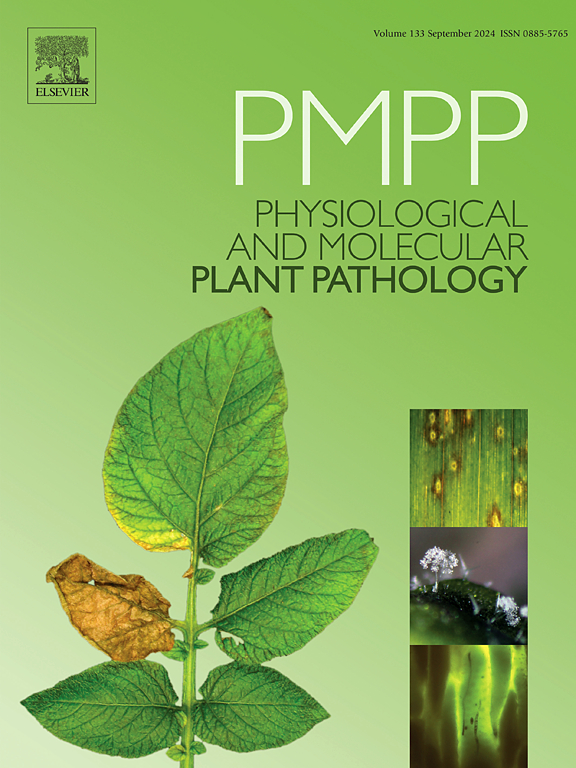豆荚(Vigna mungo, L.)种子相关真菌的变化规律Hepper):对多样性和丰富性的研究
IF 2.8
3区 农林科学
Q2 PLANT SCIENCES
引用次数: 0
摘要
紫豆(Vigna mungo, L.)作为一种高营养的豆类作物,由于与种子相关的致病性真菌菌群,近年来由于发芽率和种子活力降低,产量和生产力逐渐下降。对种子相关菌群的研究对于早期发现种子传播的致病真菌至关重要,从而有助于制定可持续农业战略以提高产量。本研究的目的是破译与蚕豆种子有关的种传菌群的多样性。采用标准吸墨法和琼脂平板法对农民田间采集的20份种子样品进行分析。根据形态鉴定出的真菌属包括镰刀菌属、巨霉属、曲霉属、青霉属、木霉属、激光双plodia、Choanephora和Diaporthe。琼脂平板法比标准吸墨纸法获得更高的菌群多样性。Fusarium和Macrophomina是优势菌群,相对丰度分别为84.25%和6.83%,在种水平上鉴定为F. incarnatum和M. phaseolina。优势菌群在种皮上的结合率最高,其次是子叶和子蕊根轴。用灭菌的盆栽混合液研究了分离菌对种子萌发和幼苗活力的影响。接种镰刀菌的种子发芽率最低,其次是大镰刀菌。我们的发现可能为不断变化的多样性模式提供有价值的见解,从而进一步帮助识别新出现的疾病。本文章由计算机程序翻译,如有差异,请以英文原文为准。

Changing pattern of seed-associated fungi in urd bean (Vigna mungo (L.) Hepper): A study of diversity and abundance
Urd bean (Vigna mungo (L.) Hepper), being a highly nutritious pulse crop has been facing a gradual decline in production and productivity in recent years due to reduced germination percentage and seed vigor, because of the seed-associated pathogenic mycoflora. Studies on seed-associated mycoflora are vital for the early detection of seed-borne pathogenic fungi, allowing for the development of sustainable agricultural strategies to increase production. The present study aimed to decipher the diversity of seed-borne mycoflora associated with urd bean seeds. Twenty seed samples collected from the farmers’ fields were analyzed using the standard blotter and agar plate methods. The fungal genera identified based on morphology include Fusarium, Macrophomina, Aspergillus, Penicillium, Trichoderma, Lasiodiplodia, Choanephora, and Diaporthe. The agar plate method resulted in a higher diversity of mycoflora than the standard blotter method. Fusarium and Macrophomina were the predominant mycoflora, with relative abundances of 84.25 % and 6.83 %, respectively and were identified as F. incarnatum and M. phaseolina at the species level. The percentage frequency of association of predominant mycoflora was higher on the seed coat, followed by the cotyledon and plumule-radical axis. The effects of isolated mycoflora on seed germination and seedling vigor were studied using a sterilized potting mixture. The lowest seed germination rate was noticed in the case of seed inoculated with Fusarium, followed by Macrophomina. Our findings may provide valuable insights into the evolving diversity patterns which further helps identify emerging diseases.
求助全文
通过发布文献求助,成功后即可免费获取论文全文。
去求助
来源期刊
CiteScore
4.30
自引率
7.40%
发文量
130
审稿时长
38 days
期刊介绍:
Physiological and Molecular Plant Pathology provides an International forum for original research papers, reviews, and commentaries on all aspects of the molecular biology, biochemistry, physiology, histology and cytology, genetics and evolution of plant-microbe interactions.
Papers on all kinds of infective pathogen, including viruses, prokaryotes, fungi, and nematodes, as well as mutualistic organisms such as Rhizobium and mycorrhyzal fungi, are acceptable as long as they have a bearing on the interaction between pathogen and plant.

 求助内容:
求助内容: 应助结果提醒方式:
应助结果提醒方式:


